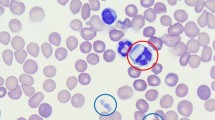Abstract
Twelve pregnant female canines, naturally infected with Toxoplasma gondii, were reinfected with T. gondii: three (GI) received tachyzoites subcutaneously (1.0 × 107), three (GII) were orally inoculated with oocysts (1.5 × 104), and six (GIII) were kept as a nonreinfected control group. All the reinfected female canines (GI and GII) miscarried or presented fetal death, while only one GIII female presented a stillborn in a litter of four pups (P < 0.01). Fever, lymphoadenopathy, miscarriage, and fetal death were the main clinical alterations observed. The highest serological titers detected through the indirect fluorescence antibody test (IFAT) were 1,024 (GI) and 4,096 (GII). In group III, the titers ranged between 64 and 256. By bioassays in mice, T. gondii was isolated in 17 organs of the reinfected adult canines, in 11 of the control group, and in 20 of the neonates. Positive immunostaining of cysts and/or tachyzoites were observed in 26 canine tissues (14 from GI and GII and ten from GIII). The agent was detected by immunohistochemistry in the encephalon of a neonate and in the spinal cord of a stillborn, thus, confirming that T. gondii infected canine fetuses, provoking miscarriages, even in bitches that presented primoinfection.
Similar content being viewed by others
References
Alton GG, Jones LM, Angus RD, Verger JM (1989) Techniques for the brucellosis laboratory. Vet Res Comun 13:420
Bresciani KDS, Costa AJ, Toniollo GH, Sabatini GA, Moraes FR, Paulillo AC, Ferraudo AS (1999) Experimental toxoplasmosis in pregnant bitches. Vet Parasitol 86:143–145
Bresciani KDS, Toniollo GH, Costa AJ, Sabatini GA, Moraes FR (2001) Clinical, parasitological and obstetric observations in pregnant bitches with experimental toxoplasmosis. Ciênc Rur 31:1039–1043
Camargo ME (1964) Improved technique of indirect immunofluorescence for serological diagnosis of toxoplasmosis. Rev Inst Med Trop São Paulo 3(6):117–118
Carlton WW, Mc Gavin MD (1998) Patologia Veterinária Especial. ARTMED, Porto Alegre
Dubey JP, Beattle CP (1988) Toxoplasmosis of animals and man. CRC, Boca Raton
Dubey JP, Mattix ME, Lipscomb TP (1996) Lesions of neonatally induced toxoplasmosis in cats. Vet Pathol 33:290–295
Elsheikha HM (2008) Congenital toxoplasmosis: priorities for further health promotion action. Public Health 122:335–353
Guesdon JL, Ternynck T, Avrameas S (1979) The use of avidin–biotin interaction in immunoenzymatic techniques. J Histoch Cytochem 27:1131–1139
Howe DK, Honore S, Derouin F, Sibley LD (1997) Determination of genotypes of Toxoplasma gondii strains isolated from patients with toxoplasmosis. J Clin Microbiol 35:1411–1414
Jacobs L, Remington JS, Melton ML (1960a) The resistance of the encysted form of Toxoplasma gondii. J Parasitol 46:11–21
Jacobs LJ, Remington S, Melton ML (1960b) A survey of meat samples from swine, cattle, and sheep for the presence of encysted Toxoplasma. J Parasitol 46:23–28
Jamara LMF, Vieira MPL (1991) Isolamento do Toxoplasma gondii de exsudato peritoneal e 254 órgãos de camundongos com infecção experimental. Rev Inst Med Trop 33:435–441
Jittapalapong S, Burin N, Nongnuch P, Chimnoi W, Kabeya H, Maruyama S (2007) Seroprevalence of Toxoplasma gondii antibodies in stray cats and dogs in the Bangkok metropolitan area, Thailand. Vet Parasitol 145:138–141
Jubb KVF, Kennedy PC, Palmer N (1993) Pathology of domestic animals. Academic, London
Kavinski LC (1980) Lesões oculares de toxoplasmose em cães clinicamente suspeitos de cinomose. Rev Setor Cienc Agrar 2:67–70
Kühn D, Oppermann WH, Rödel H, Centurier H (1972) Experimentelle infektion von Hunden mit Toxoplasma—Oozysten. Berl. Muench. Tier Wochenschr 85:309
Leiser R, Kaufmann P (1994) Placental structure: in a comparative aspect. Exp Clin Endocrinol 102:122–134
Lindsay DS, Dubey JP, Butler JM, Blagburn BL (1997) Mechanical transmission of Toxoplasma gondii oocysts by dogs. Vet Parasitol 73:27–33
Paré J, Hietala SK, Thurmond MC (1995) Interpretation of an indirect fluorescent antibody test for diagnosis of Neospora sp. infection in cattle. J Vet Diagn Invest 7:273–275
Smielewska LE, Rypula K, Dzimira S (2003) Studies on congenital toxoplasmosis in canines. Med Wet 59:141–145
World Health Organization (1967) Current problems in leptospirosis research: report of WHO expert group. Geneva, WHO (Technical report Series, 380)
Author information
Authors and Affiliations
Corresponding author
Rights and permissions
About this article
Cite this article
Bresciani, K.D.S., Costa, A.J., Toniollo, G.H. et al. Transplacental transmission of Toxoplasma gondii in reinfected pregnant female canines. Parasitol Res 104, 1213–1217 (2009). https://doi.org/10.1007/s00436-008-1317-5
Received:
Accepted:
Published:
Issue Date:
DOI: https://doi.org/10.1007/s00436-008-1317-5




